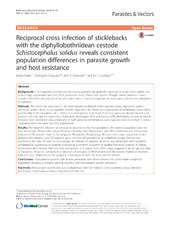Sammendrag
Background In host-parasite evolutionary arms races, parasites are generally expected to adapt more rapidly, due to their large population sizes and short generation times. There exist systems, though, where parasites cannot outpace their hosts because of similar generation times in both antagonists. In those cases concomitant adaptation is expected. Methods We tested this hypothesis in the three-spined stickleback-Schistocephalus solidus tapeworm system, where generation times are comparable in both organisms. We chose two populations of sticklebacks which differ prominently in the prevalence of S. solidus and consequently in its level of selective pressure. We performed a full factorial common garden experiment. Particularly, Norwegian (NO) and German (DE) sticklebacks, as well as hybrids between both stickleback populations and in both parental combinations, were exposed each to a single S. solidus originating from the same two host populations. Results We found the infection phenotype to depend on the host population, the parasite population, but not their interaction. NO-parasites showed higher infectivity than DE-parasites, with NO-sticklebacks also being more resistant to DE-parasites than to the sympatric NO-parasite. Reciprocally, DE-hosts were more susceptible to the allopatric NO-parasite while DE-parasites grew less than NO-parasites in all stickleback groups. Despite this asymmetry, the ratio of worm to host weight, an indicator of parasite virulence, was identical in both sympatric combinations, suggesting an optimal virulence as a common outcome of parallel coevolved systems. In hybrid sticklebacks, intermediate infection rates and growth of S. solidus from either origin suggests a simple genetic basis of resistance. However, comparison of infection phenotypes in NO-maternal and DE-maternal hybrid sticklebacks indicates local adaptation to the sympatric counterpart in both the host and the parasite. Conclusions Host-parasite systems with similar generation time show evidence for concomitant reciprocal adaptation resulting in parasite optimal virulence and host parasite specific resistance.

